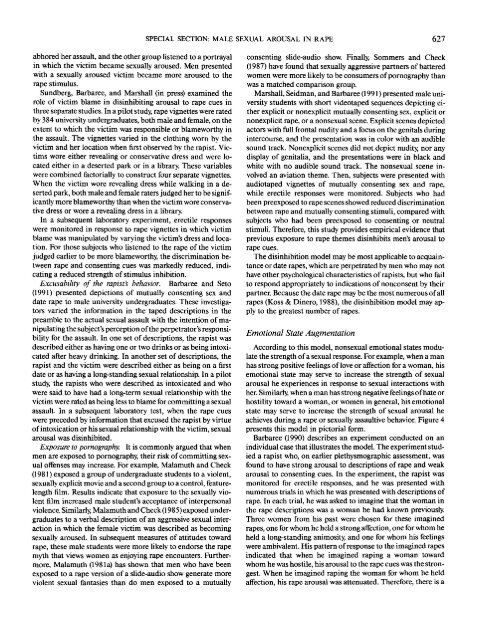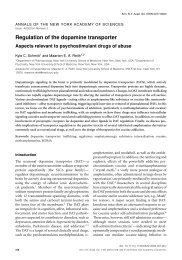The Role of Male Sexual Arousal in Rape: Six Models
The Role of Male Sexual Arousal in Rape: Six Models
The Role of Male Sexual Arousal in Rape: Six Models
You also want an ePaper? Increase the reach of your titles
YUMPU automatically turns print PDFs into web optimized ePapers that Google loves.
abhored her assault, and the other group listened to a portrayal<br />
<strong>in</strong> which the victim became sexually aroused. Men presented<br />
with a sexually aroused victim became more aroused to the<br />
rape stimulus.<br />
Sundberg, Barbaree, and Marshall (<strong>in</strong> press) exam<strong>in</strong>ed the<br />
role <strong>of</strong> victim blame <strong>in</strong> dis<strong>in</strong>hibit<strong>in</strong>g arousal to rape cues <strong>in</strong><br />
three separate studies. In a pilot study, rape vignettes were rated<br />
by 384 university undergraduates, both male and female, on the<br />
extent to which the victim was responsible or blameworthy <strong>in</strong><br />
the assault. <strong>The</strong> vignettes varied <strong>in</strong> the cloth<strong>in</strong>g worn by the<br />
victim and her location when first observed by the rapist. Vic-<br />
tims wore either reveal<strong>in</strong>g or conservative dress and were lo-<br />
cated either <strong>in</strong> a deserted park or <strong>in</strong> a library <strong>The</strong>se variables<br />
were comb<strong>in</strong>ed factorially to construct four separate vignettes.<br />
When the victim wore reveal<strong>in</strong>g dress while walk<strong>in</strong>g <strong>in</strong> a de-<br />
serted park, both male and female raters judged her to be signif-<br />
icantly more blameworthy than when the victim wore conserva-<br />
tive dress or wore a reveal<strong>in</strong>g dress <strong>in</strong> a library<br />
In a subsequent laboratory experiment, erectile responses<br />
were monitored <strong>in</strong> response to rape vignettes <strong>in</strong> which victim<br />
blame was manipulated by vary<strong>in</strong>g the victim's dress and loca-<br />
tion. For those subjects who listened to the rape <strong>of</strong> the victim<br />
judged earlier to be more blameworthy, the discrim<strong>in</strong>ation be-<br />
tween rape and consent<strong>in</strong>g cues was markedly reduced, <strong>in</strong>di-<br />
cat<strong>in</strong>g a reduced strength <strong>of</strong> stimulus <strong>in</strong>hibition.<br />
Excusability <strong>of</strong> the rapist's behavior. Barbaree and Seto<br />
(1991) presented depictions <strong>of</strong> mutually consent<strong>in</strong>g sex and<br />
date rape to male university undergraduates. <strong>The</strong>se <strong>in</strong>vestiga-<br />
tors varied the <strong>in</strong>formation <strong>in</strong> the taped descriptions <strong>in</strong> the<br />
preamble to the actual sexual assault with the <strong>in</strong>tention <strong>of</strong> ma-<br />
nipulat<strong>in</strong>g the subject's perception <strong>of</strong> the perpetrator's responsi-<br />
bility for the assault. In one set <strong>of</strong> descriptions, the rapist was<br />
described either as hav<strong>in</strong>g one or two dr<strong>in</strong>ks or as be<strong>in</strong>g <strong>in</strong>toxi-<br />
cated after heavy dr<strong>in</strong>k<strong>in</strong>g. In another set <strong>of</strong> descriptions, the<br />
rapist and the victim were described either as be<strong>in</strong>g on a first<br />
date or as hav<strong>in</strong>g a long-stand<strong>in</strong>g sexual relationship. In a pilot<br />
study, the rapists who were described as <strong>in</strong>toxicated and who<br />
were said to have had a long-term sexual relationship with the<br />
victim were rated as be<strong>in</strong>g less to blame for committ<strong>in</strong>g a sexual<br />
assault. In a subsequent laboratory test, when the rape cues<br />
were preceded by <strong>in</strong>formation that excused the rapist by virtue<br />
<strong>of</strong> <strong>in</strong>toxication or his sexual relationship with the victim, sexual<br />
arousal was dis<strong>in</strong>hibited.<br />
Exposure to pornography. It is commonly argued that when<br />
men are exposed to pornography, their risk <strong>of</strong> committ<strong>in</strong>g sex-<br />
ual <strong>of</strong>fenses may <strong>in</strong>crease. For example, Malamuth and Check<br />
(1981) exposed a group <strong>of</strong> undergraduate students to a violent,<br />
sexually explicit movie and a second group to a control, feature-<br />
length film. Results <strong>in</strong>dicate that exposure to the sexually vio-<br />
lent film <strong>in</strong>creased male student's acceptance <strong>of</strong> <strong>in</strong>terpersonal<br />
violence. Similarly, Malamuth and Check (1985) exposed under-<br />
graduates to a verbal description <strong>of</strong> an aggressive sexual <strong>in</strong>ter-<br />
action <strong>in</strong> which the female victim was described as becom<strong>in</strong>g<br />
sexually aroused. In subsequent measures <strong>of</strong> attitudes toward<br />
rape, these male students were more likely to endorse the rape<br />
myth that views women as enjoy<strong>in</strong>g rape encounters. Further-<br />
more, Malamuth (1981a) has shown that men who have been<br />
exposed to a rape version <strong>of</strong> a slide-audio show generate more<br />
violent sexual fantasies than do men exposed to a mutually<br />
SPECIAL SECTION: MALE SEXUAL AROUSAL IN RAPE 627<br />
consent<strong>in</strong>g slide-audio show. F<strong>in</strong>ally, Sommers and Check<br />
(1987) have found that sexually aggressive partners <strong>of</strong> battered<br />
women were more likely to be consumers <strong>of</strong> pornography than<br />
was a matched comparison group.<br />
Marshall, Seidman, and Barbaree (1991) presented male uni-<br />
versity students with short videotaped sequences depict<strong>in</strong>g ei-<br />
ther explicit or nonexplicit mutually consent<strong>in</strong>g sex, explicit or<br />
nonexplicit rape, or a nonsexual scene. Explicit scenes depicted<br />
actors with full frontal nudity and a focus on the genitals dur<strong>in</strong>g<br />
<strong>in</strong>tercourse, and the presentation was <strong>in</strong> color with an audible<br />
sound track. Nonexplicit scenes did not depict nudity, nor any<br />
display <strong>of</strong> genitalia, and the presentations were <strong>in</strong> black and<br />
white with no audible sound track. <strong>The</strong> nonsexual scene <strong>in</strong>-<br />
volved an aviation theme. <strong>The</strong>n, subjects were presented with<br />
audiotaped vignettes <strong>of</strong> mutually consent<strong>in</strong>g sex and rape,<br />
while erectile responses were monitored. Subjects who had<br />
been preexposed to rape scenes showed reduced discrim<strong>in</strong>ation<br />
between rape and mutually consent<strong>in</strong>g stimuli, compared with<br />
subjects who had been preexposed to consent<strong>in</strong>g or neutral<br />
stimuli. <strong>The</strong>refore, this study provides empirical evidence that<br />
previous exposure to rape themes dis<strong>in</strong>hibits men's arousal to<br />
rape cues.<br />
<strong>The</strong> dis<strong>in</strong>hibition model may be most applicable to acqua<strong>in</strong>-<br />
tance or date rapes, which are perpetrated by men who may not<br />
have other psychological characteristics <strong>of</strong> rapists, but who fail<br />
to respond appropriately to <strong>in</strong>dications <strong>of</strong> nonconsent by their<br />
partner. Because the date rape may be the most numerous <strong>of</strong> all<br />
rapes (Koss & D<strong>in</strong>ero, 1988), the dis<strong>in</strong>hibition model may ap-<br />
ply to the greatest number <strong>of</strong> rapes.<br />
Emotional State Augmentation<br />
Accord<strong>in</strong>g to this model, nonsexual emotional states modu-<br />
late the strength <strong>of</strong> a sexual response. For example, when a man<br />
has strong positive feel<strong>in</strong>gs <strong>of</strong> love or affection for a woman, his<br />
emotional state may serve to <strong>in</strong>crease the strength <strong>of</strong> sexual<br />
arousal he experiences <strong>in</strong> response to sexual <strong>in</strong>teractions with<br />
her. Similarly, when a man has strong negative feel<strong>in</strong>gs <strong>of</strong> hate or<br />
hostility toward a woman, or women <strong>in</strong> general, his emotional<br />
state may serve to <strong>in</strong>crease the strength <strong>of</strong> sexual arousal he<br />
achieves dur<strong>in</strong>g a rape or sexually assaultive behavior. Figure 4<br />
presents this model <strong>in</strong> pictorial form.<br />
Barbaree (1990) describes an experiment conducted on an<br />
<strong>in</strong>dividual case that illustrates the model. <strong>The</strong> experiment stud-<br />
ied a rapist who, on earlier plethysmographic assessment, was<br />
found to have strong arousal to descriptions <strong>of</strong> rape and weak<br />
arousal to consent<strong>in</strong>g cues. In the experiment, the rapist was<br />
monitored for erectile responses, and he was presented with<br />
numerous trials <strong>in</strong> which he was presented with descriptions <strong>of</strong><br />
rape. In each trial, he was asked to imag<strong>in</strong>e that the woman <strong>in</strong><br />
the rape descriptions was a woman he had known previously<br />
Three women from his past were chosen for these imag<strong>in</strong>ed<br />
rapes, one for whom he held a strong affection, one for whom he<br />
held a long-stand<strong>in</strong>g animosity, and one for whom his feel<strong>in</strong>gs<br />
were ambivalent. His pattern <strong>of</strong> response to the imag<strong>in</strong>ed rapes<br />
<strong>in</strong>dicated that when he imag<strong>in</strong>ed rap<strong>in</strong>g a woman toward<br />
whom he was hostile, his arousal to the rape cues was the stron-<br />
gest. When he imag<strong>in</strong>ed rap<strong>in</strong>g the woman for whom he held<br />
affection, his rape arousal was attenuated. <strong>The</strong>refore, there is a










